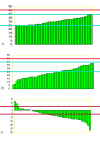Effectiveness of complete conservative treatment for adolescent idiopathic scoliosis (bracing and exercises) based on SOSORT management criteria: results according to the SRS criteria for bracing studies - SOSORT Award 2009 Winner
- PMID: 19732429
- PMCID: PMC3224944
- DOI: 10.1186/1748-7161-4-19
Effectiveness of complete conservative treatment for adolescent idiopathic scoliosis (bracing and exercises) based on SOSORT management criteria: results according to the SRS criteria for bracing studies - SOSORT Award 2009 Winner
Abstract
Background: The SRS criteria give the methodological reference framework for the presentation of bracing results, while the SOSORT criteria give the clinical reference framework for an appropriate bracing treatment. The two have not been combined in a study until now. Our aim was to verify the efficacy of a complete, conservative treatment of Adolescent Idiopathic Scoliosis (AIS)according to the best methodological and management criteria defined in the literature.
Methods: Study Design. Retrospective study. Population. We included all AIS patients respecting the SRS inclusion criteria (age 10 years or older; Risser test 0-2; Cobb degrees 25-40 degrees ; no prior treatment; less than one year post-menarchal) who had reached the end of treatment since our institute database start in 2003. Thus we had 44 females and four males, with an age of 12.8 +/- 1.6 at the commencement of the study. Methods. According to individual needs, two patients have been treated with Risser casts followed by Lyon brace, 40 with Lyon or SPoRT braces (14 for 23 hours per day, 23 for 21 h/d, and seven for 18 h/d at start), and two with exercises only (1 male, 1 female): these were excluded from further analysis. Outcome criteria. SRS (unchanged; worsened 6 degrees or more; over 45 degrees at the end of treatment; surgically treated; two years' follow-up); clinical (ATR, Aesthetic Index, plumbline distances); radiographic (Cobb degrees); and ISICO (optimal; minimal). Statistics. Paired ANOVA and t-test, Tukey-Kramer and chi-square test.
Results: Median reported compliance during the 4.2 +/- 1.4 treatment years was 90% (range 5-106%). No patient progressed beyond 45 degrees , nor was any patient fused, and this remained true at the two-year follow-up for the 85% that reached it. Only two patients (4%) worsened, both with single thoracic curve, 25-30 degrees Cobb and Risser 0 at the start. We found statistically significant reductions of the scoliosis curvatures (-7.1 degrees ): thoracic (-7.3 degrees ), thoracolumbar (-8.4 degrees ) and lumbar (-7.8 degrees ), but not double major. Statistically significant improvements have also been found for aesthetics and ATR.
Conclusion: Respecting also SOSORT management criteria and thus increasing compliance, the results of conservative treatment were much better than what had previously been reported in the literature using SRS criteria only.
Figures






References
-
- Nachemson AL, Peterson LE. Effectiveness of treatment with a brace in girls who have adolescent idiopathic scoliosis. A prospective, controlled study based on data from the Brace Study of the Scoliosis ResearchSociety. J Bone Joint Surg Am. 1995;77(6):815–822. - PubMed
LinkOut - more resources
Full Text Sources
Miscellaneous

